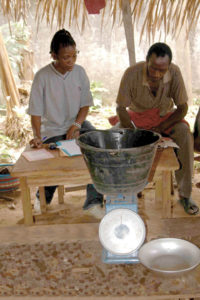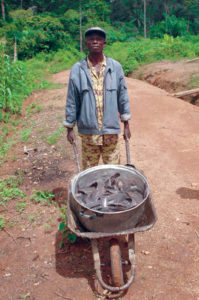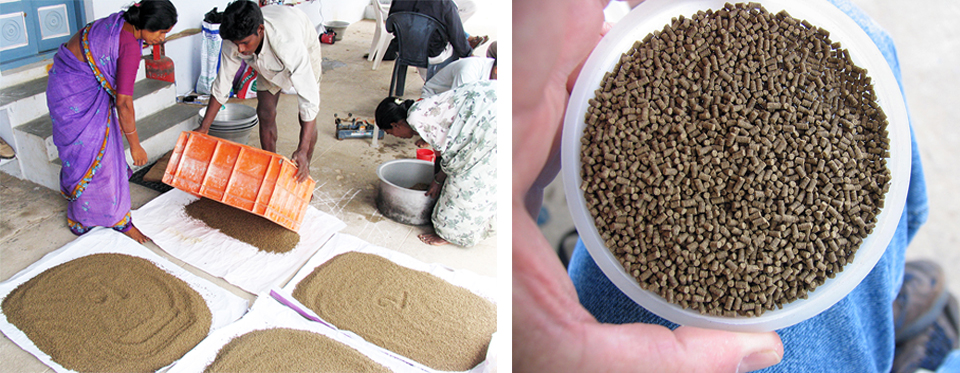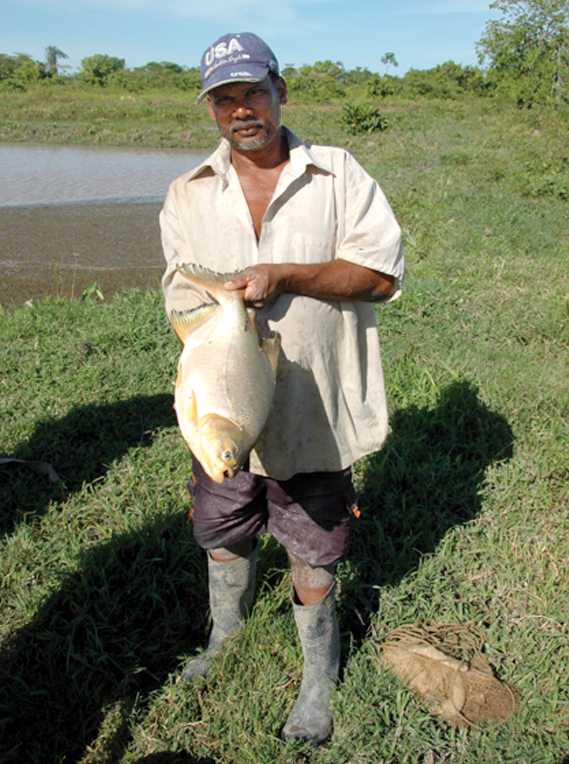A reliable value chain creates opportunities for a range of businesses

Due to social pressures to sell fish locally or give them away to friends and neighbors, as well as the difficulties associated with moving fish from distant rural areas to wealthier urban markets, selling fish for cash is often not a realistic option for rural aquafarmers in Africa. They regularly cite the many physical road blocks at which they are subjected to “informal taxation,” their fear of reprisals from existing fish traders, and the danger of carrying large amounts of cash as reasons not to take their fish to town. To overcome these constraints, collective marketing for rural farmers in central Cameroon was tested.
Previous research
From 2000 to 2006, the importance of market access for fish farmers in central Cameroon was analyzed by the WorldFish Center, International Institute for Tropical Agriculture, and L’Institut de Recherche Agricole pour le Développement de Cameroun (IRAD) with financial support from the United Kingdom Department for International Development.
The researchers found that in a comparison of areas with good or poor market access, the prices received by fish farmers were 48 percent higher, the number of buyers was three times greater, and the average purchase per customer was nearly doubled in the regions with good market access. Producers close to market sold 300 percent more fish, were 72 percent more productive, and operated at 11 times the production scale of rural producers.
For farmers with poor access, profits were not significantly improved over the project period, while in areas with good market access, net profits rose from around U.S. $387 to $1,653, with increases in fish pond income from about $105 to $1,868.
Further study
More recently, d’Etudes et d’Apui aux Populations a la Base (SEAPB), a local nongovernmental organization with experience in rural marketing, carried out further study. Technical advice on fish farming was provided by IRAD and the WorldFish Center.
SEAPB subsidized the purchase and delivery from local private hatcheries of fingerlings to members of local farmer groups in Yemssoa and Akono, rural villages with poor access to the Yaoundé urban market. A polyculture of catfish and tilapia was grown for about 10 months.
At harvest, all fish were weighed and transported to Yaoundé with two representatives of the fish farmers’ group, who witnessed their sale in the Tsinga neighborhood to passing members of the public, women retailers known locally as “buyem-sellums,” hotels, restaurants, and private households. All cash transactions were recorded, and after the money advanced for fingerlings was deducted, the balance was given to the representatives to take back to the villages.
Results

Of the 32 farmers from two villages who took part in the trial, 12 netted about U.S. $42 – enough to completely repay their debts. Seventeen farmers partially repaid but gained nothing because the cost of fingerlings exceeded revenues at harvest. Three paid nothing.
For those who did not repay, one harvested prior to the program date and thus avoided supervision. A second opted to eat all the fish, and the third had no production, probably due to high fingerling mortalities resulting from poor handling prior to stocking. Overall, 65 percent of the cash advanced was recuperated by SEAPB.
Although the longer-term impacts of this effort were not immediately measurable, preliminary observations indicated that instead of selling 50 percent of their harvest, farmers in the test group took advantage of the opportunity and sold 100 percent of their fish for cash. The average price received by the farmers varied U.S. $2.45-3.95 per kilogram, depending upon whether the fish were sold to wholesalers or restaurants. In addition, the number of farmers interested in collective marketing rose from 32 to 60 within three months of harvest.
Improved fish production and marketing made substantial contributions to the 22 women who historically dominated live fish retailing in Yaoundé. Market survey data estimated that these women sold about 500 kg of fish daily at an average retail price of U.S. $5.36 per kilogram. Prior to the collective-marketing scheme, none of the fish sold by local fish farmers was formally marketed. The fish were sold on pond banks directly to consumers. The collective-marketing experiment helped the women sell 392 kg of fish and netted them $628.
The 65 percent cash-recovery rate was insufficient to ensure sustainability. However, the pilot study made no effort to screen participants, and with some experience, the rate of cost recovery should be much higher. If somewhat higher-income farmers were targeted, so that larger quantities of inputs were sold to each farmer, costs for the delivery of services could be reduced at the same time as productivity and profitability increase, improving the ability of farmers to repay their credits.
Increasing stakeholder opportunities for small-scale fish farmers
The possibility for extending an NGO-mediated, collective-marketing system for rural producers should be of interest to governments and donors seeking to help alleviate rural poverty.
Not only are fish a high-value product, but by purchasing inputs and selling outputs for cash, a value chain is created that increases opportunities for a range of stakeholders in wholesaling, retailing, transporting, and processing.
In Cameroon, an annual profit of U.S. $1,807 for the farmer also earns $2,533 for input suppliers and another $600 for local retailers. If scaled out to reach all of the estimated 2,000 fish farms in central Cameroon, 5,300 metric tons of fresh fish could be added to the food supply and an additional $57.8 million put into the local economy through the aquaculture value chain. Interventions at this scale could make significant impacts on rural poverty and economic growth in Africa.
(Editor’s Note: This article was originally published in the September/October 2007 print edition of the Global Aquaculture Advocate.)
Now that you've reached the end of the article ...
… please consider supporting GSA’s mission to advance responsible seafood practices through education, advocacy and third-party assurances. The Advocate aims to document the evolution of responsible seafood practices and share the expansive knowledge of our vast network of contributors.
By becoming a Global Seafood Alliance member, you’re ensuring that all of the pre-competitive work we do through member benefits, resources and events can continue. Individual membership costs just $50 a year.
Not a GSA member? Join us.
Author
-
Randall E. Brummett, Ph.D.
Senior Scientist
WorldFish Humid Forest
Ecoregional Center
B.P. 2008 (Messa)
Yaoundé, Cameroon
Tagged With
Related Posts

Health & Welfare
10 paths to low productivity and profitability with tilapia in sub-Saharan Africa
Tilapia culture in sub-Saharan Africa suffers from low productivity and profitability. A comprehensive management approach is needed to address the root causes.

Health & Welfare
A holistic management approach to EMS
Early Mortality Syndrome has devastated farmed shrimp in Asia and Latin America. With better understanding of the pathogen and the development and improvement of novel strategies, shrimp farmers are now able to better manage the disease.

Aquafeeds
A look at India’s fish feed industry
India's fish-farming industry makes limited use of modern feeds, providing potential for the feed sector to grow. Commercial feeds are predominantly used for pangasius farming, followed by a rising popularity in carp culture.

Health & Welfare
A look at aquaculture in Guyana
With its large quantities of water and little industry to pollute it, Guyana has the potential to become a greater player in global aquaculture.



